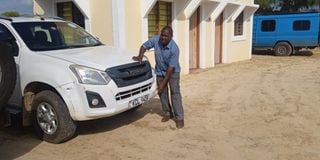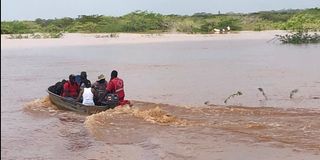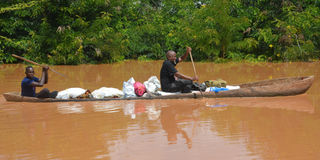Premium
Floods have locked us in Lamu for more than a week, here is what our daily struggle is like

NMG driver Dominic Magara in Lamu where motorists have been stranded for over a week now after the Lamu-Garsen-Witu road was closed due to flooding.
What you need to know:
- Road transport to and from Lamu County has been paralysed after the Garsen-Witu-Lamu road was closed. Mr Dominic Magara, a Nation Media Group driver who is among those stranded, narrated his ordeal to nation.africa.
- Daily, we have to hassle for meals which are getting scarce. As we start a new week, we hope that we will leave this area and join our families who we must call more than five times a day to assure them of our safety, Dominic says.
For over a week now, road transport to and from Lamu County has been paralysed after the Garsen-Witu-Lamu road was closed. The Kenya National Highways Authority ordered the road closed after floods cut off the highway at Gamba and Lango la Simba. Several motorists and passengers were stuck at these sections, leaving them with tough challenges for their upkeep. Mr Dominic Magara, a Nation Media Group driver who is among those stranded, narrated his ordeal to nation.africa.
A road trip to Lamu from Mombasa whether by public or private means can be challenging if one is time-conscious.
It is a 350-kilometer journey that normally takes five to six hours, but security incidents along the way especially within Lamu County may result in cancellation of the trip or waiting for long hours for the issue to be cleared.
When the Nation team set off from Mombasa to Lamu on November 28, our past experiences along the highways heading to Lamu were on the back of our heads.
We were all cognisant of the need to remain vigilant, follow every security instruction along the way and be wary of strangers who might want to stop the vehicle.

A Kenya Red Cross official assists journalists to cross a flooded section of the Lamu-Garsen-Witu road in this photo taken on December 3, 2023.
Little did we know that the adventure we will live to tell will not be about encountering security challenges, at least so far, but getting stranded because of floods.
After a short prayer that morning, we hit the road at around 7.30 am. Our mission was to cover Lamu Cultural Festivals, a three-day event on the island recognised as a UNESCO cultural site.
We broke the journey into two, stopping over for a brunch in Malindi. This is the last major town on the northern frontier where motorists and road travellers are assured of needs such as fuel, snacks and drinking water. A long stretch of the highway to Lamu lacks much human activity.
At around 9 am we set off from Malindi heading straight to Minjira, the main junction to Lamu as one exits Mombasa-Garissa Highway and drove towards Itsowe.
This is where the River Tana is— one can be in Tana River County and fail to locate the direction of the river.
I noticed from here that all armed officers inspecting vehicles wore jungle uniforms, hiding their faces. There were no pleasantries nor friendly talk, only orders and instructions.
In this area, inspection and identification took less than a minute and we proceeded to Gamba. More officers enquired about our mission and the progress of our journey.

Passengers walk through the flooded Tana Delta region.
After about 20 kilometres, we saw an armoured personnel carrier (APC) parked at the edge of the road. I was signalled to slow down and stop. Initially, I saw one officer but moving closer I spotted five and another car hidden in the bush.
A polite order was issued that we should all get out and we obeyed. We identified ourselves and were given a debrief about the road ahead.
Peter Wainaina, the NMG cameraman, was eager to know the branch of the military officers because that was the first time we all had seen such a uniform.
The officer identified himself as one of the many Special Forces operating in that sector taking care and handling any security issue that may arise within the Lamu Corridor.
The officer advised me not to stop unless I was ordered to do so by someone in a uniform similar to his or a normal uniformed Kenyan police, especially on the roadblocks ahead. At this point, some of us were getting worried as to whether our security was assured, but we journeyed on.
There were about three roadblocks on the entire stretch of 113 kilometers. We arrived at Mokowe Jetty safely, at around 1.30pm. The TV broadcast equipment was offloaded and the team of reporters took a speed boat towards Lamu Island.
Our crew from Nairobi joined the Mombasa team later, and the drivers settled on the mainland since vehicles could not drive to the island.
Sudden change
On the third day, it started raining heavily, hampering movement. At times, the few hotels around lacked a variety of meals because transportation of commodities had started to be disrupted by the rains.
We opted to walk to Mokowe Township, three kilometers away, and this became our refuge for our daily bread.
However, our refuge also got hit with the commodity shortages and life started to change suddenly, with everything becoming very expensive. Water that costs Sh50 was going for Sh70.
Apart from the rains, most traders had moved to the island where business was booming because of the festivities, leaving behind a few businessmen who took the chance to hike prices exorbitantly.
Soon, reports started spreading that rainwater from Garissa, Wajir and Ukambani regions was draining down to the Tana Delta and onwards to the Indian Ocean. Lamu, being a neighbouring county to the Tana ended up being a casualty to these floods heading downstream.
Things got worse as all movement in and out of Lamu by road came to a halt. Prices of all commodities shot up further. Only cereals and fish were available. There were no vegetables.
Out of panic, guests who were in Lamu Island started to move out, prompting public service vehicles to double fares.
We heard rumours that the road had been submerged. As it was our last day, we had to leave so we packed our belongings and departed.
As we drove in a convoy of four vehicles, there were massive floods on both sides of the road that were in the last few days covered with vegetation.
At Gamba, the road was completely impassable as it was submerged for about three kilometers.

Residents of Lamu Delta use a canoe to transport their belongings after their homes were flooded due to the ongoing El Nino rains.
Essential goods were no longer coming nor leaving Lamu. Fish traders were counting losses as they could not ferry them out of the county. Within 24 hours of the order to close the road, most fuel stations had run out of the commodity.
Our team of reporters took a day to figure out the next step and decided to take a boat across the flooded section of the road then use a vehicle to Malindi and onwards to Mombasa. Some of them were heading to Nairobi.
As for the rest of us, we had to adopt a wait-and-see strategy as we could not risk driving the vehicles across the floods. In any case, the government had ordered the road closed.
We are now entering two weeks since the road was closed. No official communication has been provided on the measures put in place to return normal activities to and from Lamu.
Food, accommodation and parking are getting more expensive by the day. Security threats cannot allow us to roam around as freely as we would love to. One can only imagine the kind of situation being encountered by residents in the county’s remote areas under the situation.
Daily, we have to hassle for meals which are getting scarce. As we start a new week, we hope that we will leave this area and join our families who we must call more than five times a day to assure them of our safety.
During nights, a large swarm of flies and mosquitos keep us company. Their melodies are annoying but at least it is a sign of life in the darkness.





